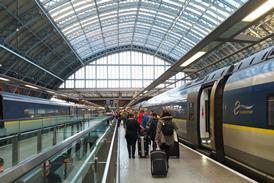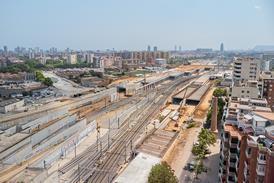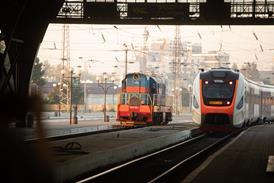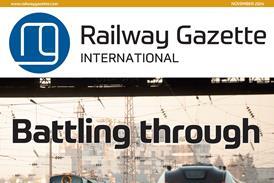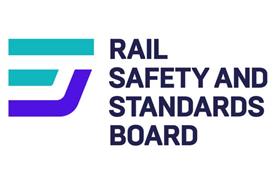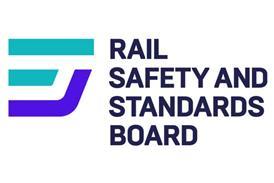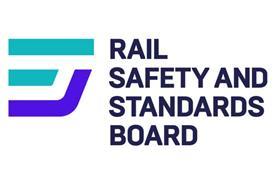BYLINE: Union Railways South has the challenge of completing the first phase of the Channel Tunnel Rail Link by October 2003. Newly-appointed Managing Director Chris Jago told Chris Jackson that a partnership with project managers Rail Link Engineering promised ’a win-win solution’
INTRO: Union Railways South has the challenge of completing the first phase of the Channel Tunnel Rail Link by October 2003. Newly-appointed Managing Director Chris Jago told Chris Jackson that a partnership with project managers Rail Link Engineering promised ’a win-win solution’
BYLINE: Chris Jago
Managing Director Union Railways South
ON FEBRUARY 24 London & Continental Railways successfully completed the issue of government-guaranteed bonds worth £2·65bn to fund construction work on the Channel Tunnel Rail Link between London and Cheriton. Financial close also triggered the legal creation of two LCR subsidiaries that will carry forward planning and construction of the new line.
Union Railways South takes overall responsibility for construction of Section 1 between Cheriton and Fawkham Junction (map p296), inheriting the ’client’ role from LCR for the construction contracts let last October. Although URS is an LCR subsidiary, it is effectively controlled by Railtrack, which is committed to buying the line on completion. Reflecting this, the company is headed by Chris Jago, former Director of Railtrack’s Southern Zone, who transferred to the CTRL project from the beginning of January.
Jago explains the complex relationship between the various parties arising out of the rescue package put together last June (RG 7.98 p440). ’When Railtrack came into the project as partners, and agreed to buy Section 1 at cost when complete, LCR’s client management subsidiary Union Railways Ltd (URL) was split into two companies, Union Railways South and Union Railways North.
’Railtrack has control over the personnel of URS and appoints the Senior Management, but for legal reasons to do with the concession agreement URS is still owned by London & Continental Railways. URS is not a subsidiary of Railtrack; its finances are reported in the LCR books. But as Managing Director of URS, I report to the Railtrack Group Board and have virtually no responsibilities to LCR.’
Railtrack has an option to purchase Section 2 which must be exercised by June 1 2003, but Jago says the company expects to decide one way or the other ’around 2001, depending upon the outcome of the Regulator’s Periodic Review into track access charges on the existing network.’ In the meantime, he has an overriding consideration: ’all works that are done on the southern section of the route must make allowance for the northern to follow.’
Although the contracts are being let in the name of URS, Jago says that anything over £50m must go to the Railtrack Group Board for authorisation. ’My job, apart from the MD’s role, is to protect Railtrack’s interests in the project. Railtrack is committed to buy Section 1 at cost, so I must make sure the project is delivered on time (October 2003) to the agreed specifications, both in terms of quality and performance, and on price, or better still under. To do that, we have inherited a whole suite of agreements, of which the most important is with Rail Link Engineering as project managers and designers’ (p291).
Management partnership
When he arrived at the beginning of January, Jago was ’impressed by the universal belief in a partnership between Union Railways and RLE.’ This was defined in a Partnership Mission Statement agreed between URL and RLE in 1998, and ’I want to put this into practice to ensure that we have a good working relationship.’
Jago says the relationship is ’far better than I had expected it to be ... the willingness and openness is very encouraging.’ Coming into the project afresh, he can take an independent view: ’I have no wish to be confrontational, but I have seen confrontation at the interface. When the project was nearly buried, a lot of good guys were paid off, and morale was low. We have to build that back up.’
Good relations should be cemented by the project management contract, which ’is a very good deal for RLE and Railtrack. There is a very clear win-win solution if we can deliver the specified project early and below target price.’
Jago recognises that ’there will be hiccups as in any relationship’, but to help minimise these the RLE Project Director sits in at the URS weekly review meetings. ’RLE also has regular meetings with the contractors, which we attend, to monitor for quality and safety. URS will be monitoring the "systems" and RLE the "actuals". We don’t want the circular checking to get out of hand, but we need to make sure it happens. Two or three years after the line opens, the engineers and contractors will have moved on, but Railtrack will still be here. We have the biggest interest in ensuring that we have a quality product.’
Specifications into designs
Design is firmly RLE’s responsibility. Jago feels that the URS-RLE partnership will have an important role as the project evolves. ’A lot of work has been done since the route was selected in 1993 - the last thing we want to do now is change the specification. In buying into the project, Railtrack undertook due diligence, and felt that the specification was deliverable.
’But the specifications are largely output based, for example setting point-to-point timings rather than speeds for any given section of line. Maybe we will need to look at the way in which the journey time savings are delivered.’
As an example, Jago highlights the requirement that the line be engineered for freight. ’But what sort of freight? No high-speed line I know of carries ordinary loose-coupled freight trains, and with up to eight high-speed and eight Kent Express trains an hour there won’t be room for slow freight on the CTRL.’ Heavy axleloads which have a severe impact on track maintenance costs probably could not be justified.
However, ’there is certainly scope for fast freight trains built to passenger specifications, and I can imagine some forwarders might be very interested in this kind of operation.’ Jago suggests that high-speed rigid-coupled freight trains ’may need a loco type that doesn’t exist at this time. A 200 km/h plus version of the Royal Mail Class 325 postal EMUs fireproofed for the Channel Tunnel would be a very exciting project.’
Tendering and contracts
Construction of Section 1 has been split into six main civil engineering packages, two system-wide contracts for track/electrification and signalling, plus others covering the interfaces with the existing Railtrack network (Table I). The last of the six civil works contracts was let on April 6. Some interface works have also been let, and tenders for the system-wide packages will be invited in the next month or two.
In the tendering process, RLE acts as an agent for URS, putting together the contract form, issuing the invitations to tender and undertaking a prequalification assessment in conjunction with URS representatives. RLE makes a recommendation for a preferred contractor, using a weighted scoring - price, partnership arrangements (both within any joint venture and between the contractor and RLE), and technical merit.
Jago feels that the new structure will enable URS to benefit from Railtrack’s extensive experience of contract letting. ’We can tap into Railtrack’s Directorate of Contract & Supply to review both the process and the conclusion. Once a preferred bid has been identified, it is passed to the URS Board, and then to the Railtrack Group Board for authorisation.’
The CTRL is the biggest main line railway to be built in Britain for 100 years. Given the massive cost and time over-runs during construction of the Channel Tunnel, how is URS protecting itself against similar problems? ’Railtrack maintains a risk register, looking at costs and time overruns for major projects’, says Jago. ’Britain has a relatively poor record in this regard, with a few notable exceptions. We are determined that Section 1 will be another exception. RLE, Railtrack and the contractors all have a common financial incentive to come in on time and under budget.’
In the June 1998 refinancing package the Target Cost Estimate for Section 1 is £1·7bn (Table II). Railtrack expects to buy an 80-year exclusive lease of the line for £1·5bn, the remainder being made up of Government grants.
Land for the rail link is being acquired by another LCR subsidiary, L&C Stations & Property, but ownership will be vested in the Secretary of State responsible for transport (currently the Department of Environment, Transport & the Regions) on behalf of the government. Railtrack will lease the land as part of its overall operating lease of the line.
The construction contracts are based on New Engineering Contract forms - using target price contracts and open book pricing. Jago says there is a built-in incentive for a contractor to drive his costs down. ’This is better than fixed-price contracts [as used by Eurotunnel] which can get very contractual, with Variation Orders being issued every time the client sneezes.’
As to keeping the project on schedule, ’it’s early days yet; there have been a few hiccups, but these have been containable. There is lots of slack time in some contracts - although the completion date for the civil works is June 2001, the programme envisages December 2000.’
One cause of delay has been land acquisition. ’When it was a single project, CTRL was to have been delivered from north to south. But the restructuring switched this to building the southern section first. Land acquisition and accommodation works were to have been ready by the time the contractors were on board, but as the design emerged, land requirements changed, and we have not always had the free access that would have been ideal.
’Ironically, the location where we decided to put the site office for one contract was the only section where we needed bailiffs to get possession of the land. To make things worse, November and December were extremely wet, which meant poor conditions for setting up, laying in concrete access roads, and so on - at times the contractors were wallowing in a mud bath. But they are now working productively.’
The tracklaying programme is governed by the need to get through the North Downs tunnels, so this leaves more recovery time to the north. ’If the tunnel is finished early, we can start on the system-wide works earlier, subject to logistics of materials supply.’
The tracklaying base will be at Beechbrook Farm, between Ashford and Charing, where the CTRL runs alongside the existing line and M20 motorway. Over 700000 tonnes of ballast, 20000 tonnes of rail, 270000 sleepers, 48 switches and crossings, 165 km each of contact, messenger and feeder wire, and 1000 km of signalling cables will pass through the site during the two-year fit-out phase.
Managing the safety risk
URS is conscious of the need to ensure safety, both during construction and on the completed line. Given the high profile of the project, ’if ever there was an incentive to manage risks, this is it.’
For the construction phase, URS has its own safety management statement and an annual plan. Jago’s aim is to avoid any accidents, ’which are a cost to the project in rectification, compensation, delays, prosecutions, local pressure and reactions.’
Railtrack’s existing Group Standards are being rewritten to encompass high-speed operation. HM Railway Inspectorate is closely involved, but Jago points out ’this is new territory for them as well.’ HMRI and URS representatives regularly cross the Channel to France, Belgium and Germany ’to look at the practicalities of existing experience, and see what works and what doesn’t.’
The platforms at Ashford International highlight a conundrum for URS with regard to European directives. Jago says two bits of EU legislation are directly contradictory: ’it’s a case of which law do we break?’ One directive requires all new railways in Europe to be built to UIC standards, which would require the tracks through Ashford to be raised, to lower the existing platform height relative to the rails. The other requires full disabled access, including high platforms to meet British Disability Discrimination Act regulations (RG 1.99 p24). URS would like to keep the existing platform height.
Part of a national network
Another task facing Jago in the next few months is to reintegrate the CTRL with the rest of the British railway network. Originally the link was promoted by British Rail, but the transfer of Union Railways Ltd to LCR when the private sector took over in 1996 led to it being developed as a stand-alone railway.
’Although a co-operation agreement was signed by the Department of Transport, the South Eastern Train Operating Company (as it then was) and Railtrack when the project was launched, Railtrack had nothing to do with the CTRL. Up to last year it seemed as if there was almost a brick wall between LCR and Railtrack - there was little evidence of any joint involvement or co-operation.
’But building a new line needs a lot of co-operation - now even URL admits that if Railtrack hadn’t bought into the scheme it could have been difficult to deliver. The Ashford remodelling in particular would have been extremely hard.’
Railtrack sees the CTRL as an intrinsic part of its network, and Jago envisages that Section 1 will probably be treated as ’part of Southern Zone - effectively a Maidstone bypass on rails. It may be a different type of railway, but it’s not really that special. Operating it as part of Railtrack will make it easier to release paths on the existing network.’
Crucial to this integration will be Contract 434, covering the interfaces with the existing network at Cheriton, Dollands Moor, and Ashford. This was awarded on April 6. ’Contract 434 is very important, as one of my secondary objectives is to minimise the impact of CTRL construction on the existing network. We will get Railtrack’s Major Projects team and Southern Zone involved - the zone has a lot of hard-won recent experience with resignalling contracts, which RLE has not.’
Integration will also have repercussions in terms of control and maintenance. ’Incredible as it seems, there was to be a separate CTRL control centre at Ebbsfleet, with three signalmen and two electrical controllers on duty for each shift’, says Jago. ’Now, it may make more sense to integrate the signalling for Section 1 into Ashford IECC. We could bring the power control into Ashford or the existing centre at Paddock Wood. In any case, we may be looking at the next generation of train control by 2003 under the Network Management Centre strategy.’
URS is still looking at the question of maintenance of the line, and the provision of rapid response to equipment failures or other incidents. Jago suggests that it is ’likely’ that the Southern Zone infrastructure maintenance contract could be extended to include Section 1 from 2003. ’After all it should be a very reliable railway, and adding high-speed expertise into the Kent IMC would likely be cheaper than having a dedicated response team.’
The alternative would be to award a combined installation and maintenance contract. But with track/electrification and signalling being let as separate contracts for each of Sections 1 and 2, Jago fears a multiplicity of responsibilities. ’It seems pointless to create two, three or even four separate maintenance teams ... it may be better for the zone IMCs to maintain the line, with the suppliers providing a warranty for their equipment and dealing with any component repairs off-site.’
CAPTION: At Cuxton on the west bank of the Medway contractors are already making an impact on the landscape
Positive partnership that will deliver on time.
Union Railways South is tackling the challenge of completing the first stage of the Channel Tunnel Rail Link by October 2003. Managing Director Chris Jago talked to Chris Jackson about the partnership with Rail Link Engineering
Key facts:
Section 1: Channel Tunnel - Fawkham Jcn, 69 route-km; cost: £1·7bn; opens October 2003
Section 2: Fawkham Jcn - London St Pancras, 39 route-km; cost: £2·5bn.
Opening: Railtrack has option to purchase 80-year lease by June 2003, allowing opening in 2007
Maximum speed: 300 km/h, but the line will also carry 200 km/h commuter trains
Major structures:Ashford approach tunnel (1·7 km); Medway river bridge; North Downs tunnel (3·2 km); Thames river tunnel (3·xkm); London tunnel 19·xkm)
Un partenariat constructif pour faire l’heure
Union Railways South relève le défi d’achever la première phase de la ligne Londres-Tunnel pour octobre 2003. Chris Jackson a recueilli les propos du directeur général Chris Jago relatifs au partenariat avec Rail Link Engineering
Eléments clés:

